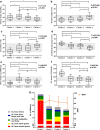An optimal glycemic load range is better for reducing obesity and diabetes risk among middle-aged and elderly adults
- PMID: 33752703
- PMCID: PMC7983372
- DOI: 10.1186/s12986-020-00504-5
An optimal glycemic load range is better for reducing obesity and diabetes risk among middle-aged and elderly adults
Abstract
Background: Due to the lack of evidence, advice pertaining to glycemic load (GL) can be misleading. Does the excessive restriction of GL, mostly through an extreme reduction in carbohydrate intake, result in a relatively high intake of fat and protein and result in overweight and obesity? This study was performed to initially explore the optimal GL range.
Methods: A cross-sectional study involving 2029 participants aged 40 years or older in Guangzhou, China was conducted. Participants were divided into four groups according to cluster analysis. Dietary data were assessed using a previously validated 3-day food record.
Results: Instead of participants with the highest [cluster 1, median (interquartile ranges) GL was 112(107-119)/1000 kcal] and the lowest GL intake [cluster 4, 90(82-96)/1000 kcal], those with moderate GL intakes [clusters 2 and 3, 93(85-102) and 93(85-99)/1000 kcal, respectively] had a lower prevalence of overweight, obesity and diabetes. In addition, clusters 2 and 3 were more consistent with the macronutrient intake reference with adequate micronutrient intake. Therefore, the optimal GL range was determined to be (85-100)/1000 kcal, rather than "lower is better".
Conclusions: Reducing the GL intake to prevent diabetes deserves more attention in the context of a balanced diet. An appropriate GL may be better than excessive restriction.
Keywords: Cluster analysis; Diabetes; Glycemic load; Obesity.
Conflict of interest statement
The authors declare that they have no competing interests.
Figures




References
-
- National Diabetes Research Cooperative group A mass survey of diabetes mellitus in a population of 300,000 in 14 provinces and municipalities in China (author’s transl) Zhonghua Nei Ke Za Zhi. 1981;20:678–683. - PubMed
LinkOut - more resources
Full Text Sources
Other Literature Sources

